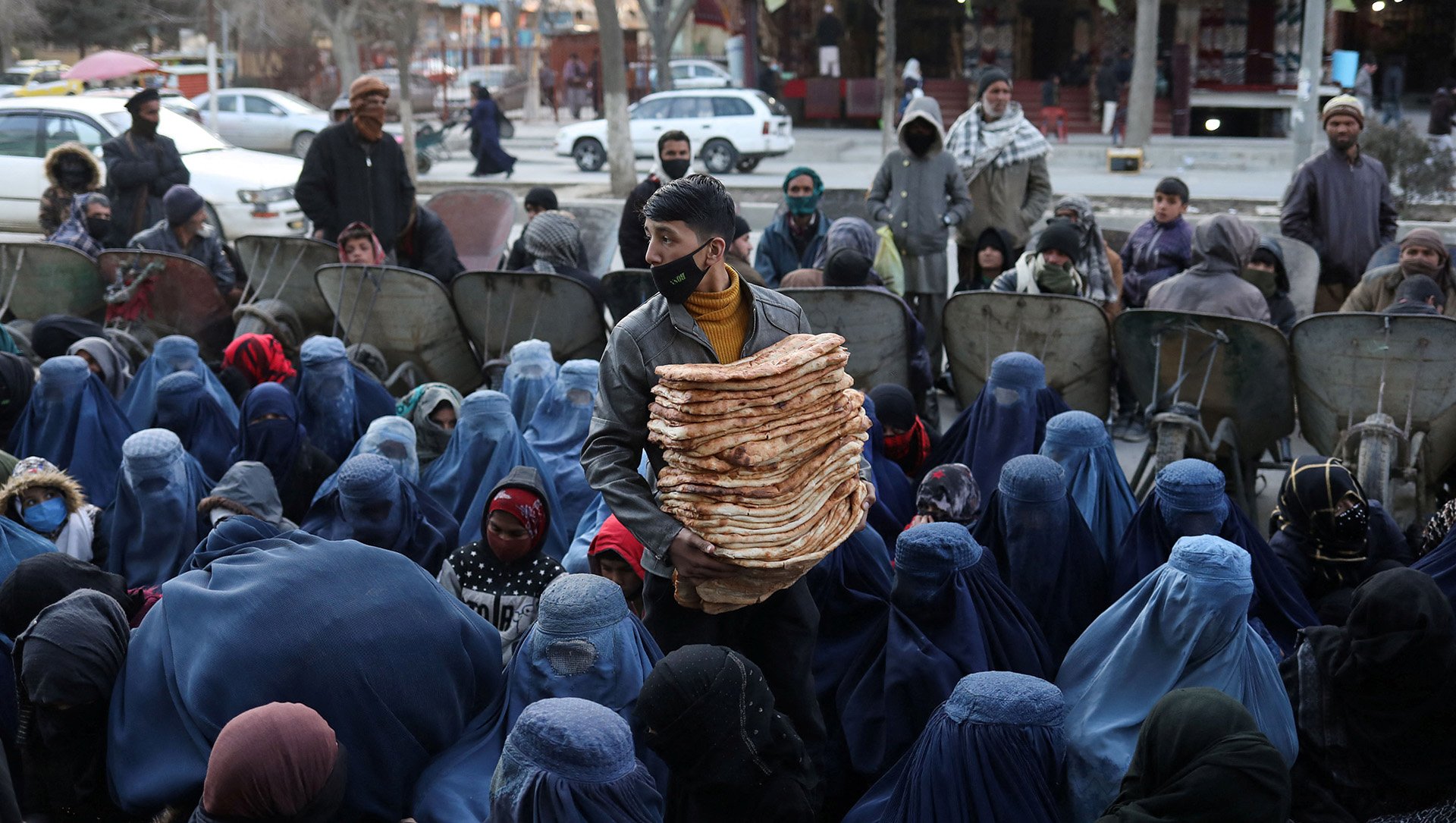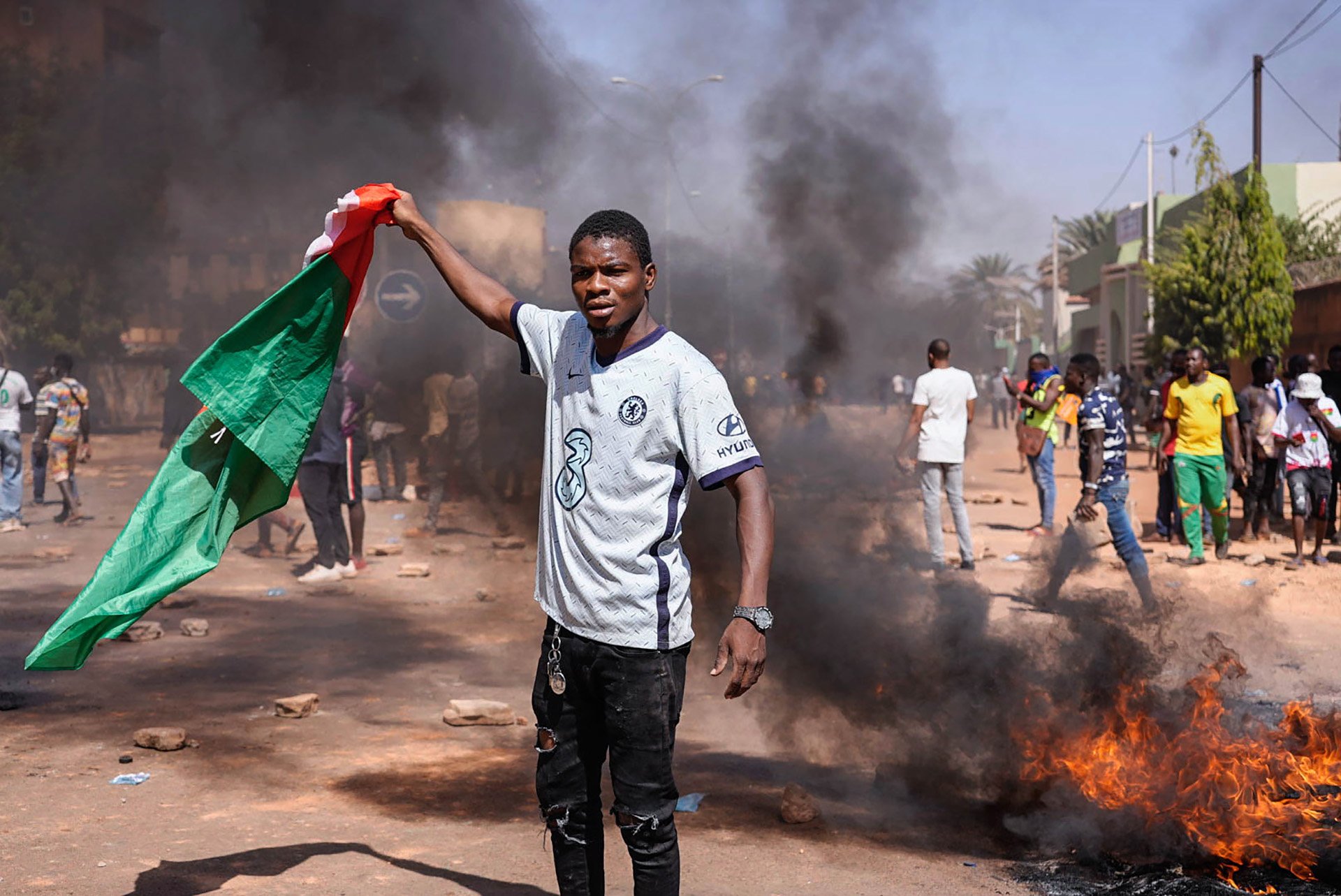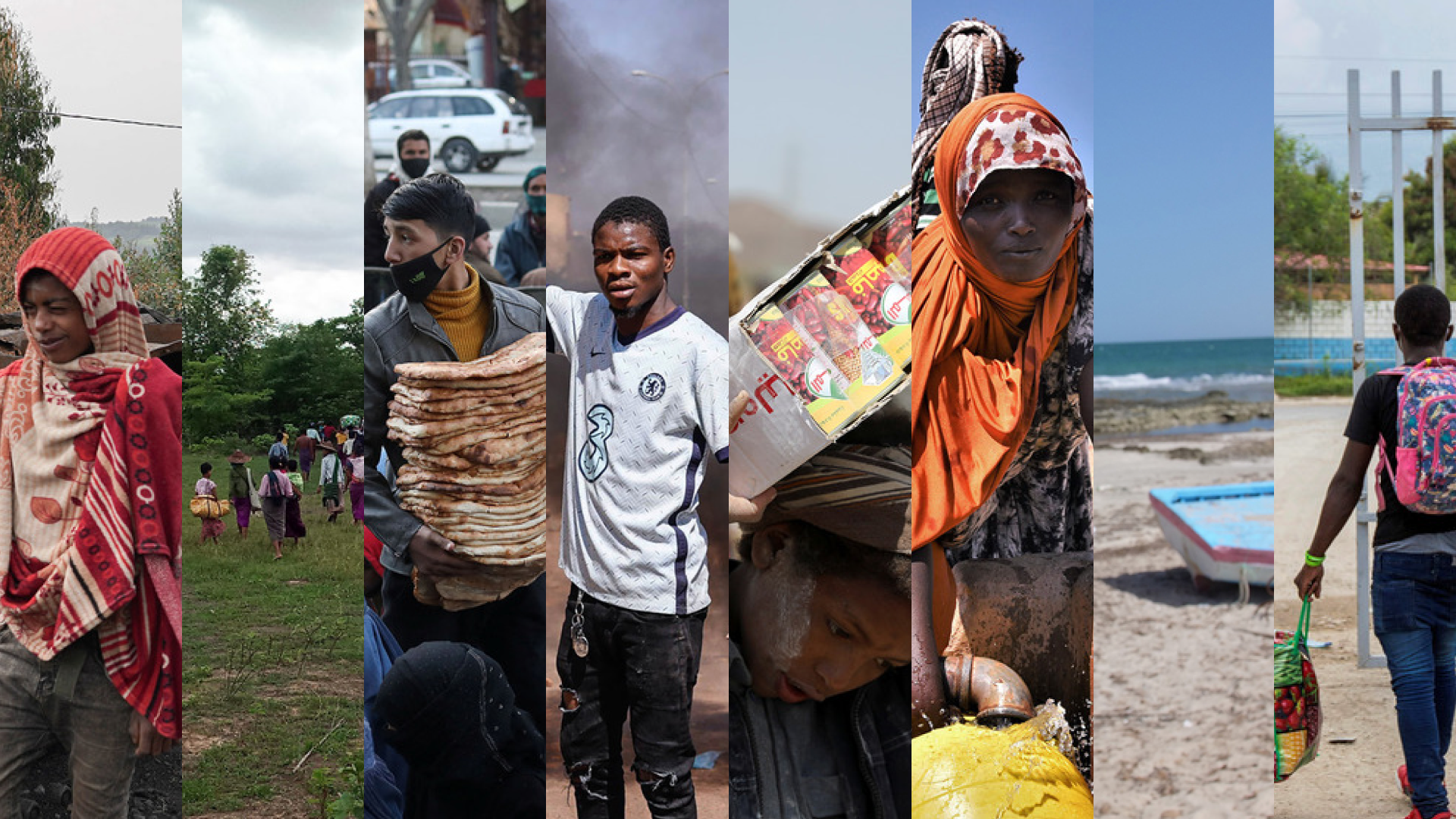With the world’s focus on Ukraine, we cannot forget other crises around the globe, especially as the economic impacts of the Russian invasion are being felt far and wide, and with the gap between humanitarian funding and soaring emergency aid needs already at record levels.
Here are eight (among many) conflicts and crises – listed in no particular order – that are also happening right now, and that also deserve your attention.
The Horn of Africa
Crisis:
Drought and regional food insecurity
Number of people impacted or in need of aid:
13 million, rising to 20 million

What is happening? The harshest drought in 40 years has pushed an estimated 13 million people in the Horn of Africa into extreme hunger – and it could get worse.
Three failed rainy seasons back to back have decimated the livestock on which local economies depend. A new rainy season should be underway this month, but temperatures are still unusually high. Should that signal an unprecedented fourth drought in a row, as is feared, then numbers in need are predicted to rocket to 20 million.
In Somalia, the worst-affected country, 4.3 million people are going hungry, and the alarm has been rung over a repeat of the 2012 famine. In Ethiopia, the drought is compounding the humanitarian disaster of the war in the country’s north, while in neighbouring Kenya’s pastoralist zone, the loss of cattle is triggering raids and clashes between communities.
The droughts – driven by a climate heating and La Niña weather pattern – have hammered an already poor and vulnerable region. Aid agencies were already warning that when the rains finally do come, recovery will be painfully slow. But now, with wheat and fertiliser prices soaring due to the situation in Ukraine, the Horn of Africa will also face more competition for short-term assistance as hunger crises emerge in other countries and regions.
Myanmar
Crisis:
An explosion in post-coup humanitarian needs
Number of people impacted or in need of aid:
14.4 million in need of aid

What is happening? The Myanmar military’s February 2021 coup has been nothing short of a disaster. Humanitarian needs have multiplied and continue to spiral: UN-backed emergency plans counted one million people in need of aid just before the coup; that number is now 14 million.
At least 500,000 people (and climbing) have been displaced since the coup, poverty levels are the worst in years, and a quarter of the population is food insecure.
But the figures only hint at the depth of the problem. Violent new conflicts have spread across the country. Facing a new wave of anti-coup militias, the military has launched airstrikes, artillery bombardments, and aid blockades that have directly targeted civilians. Hunger is rising in key agricultural heartlands, where many cash-strapped farmers can’t afford to plant crops.
“There is an atmosphere of fear everywhere,” one Myanmar aid worker said.
Comparing humanitarian needs across disparate crises may be a fruitless exercise. Still, aid workers who struggled to get attention for Myanmar last year noted the relatively ample resources quickly made available for Afghanistan months later. Similarly, Myanmar civil society groups have watched as governments line up to support Ukraine while condemning and sanctioning Russia – after they took a far more reserved approach with Myanmar and its widespread anti-coup movement.
“The situation in Ukraine has shown that the international community can act swiftly and in a largely united way,” noted Progressive Voice, a Myanmar advocacy group.
Afghanistan
Crisis:
Economic freefall spurs record aid needs
Number of people impacted or in need of aid:
22.1 million targeted for aid

What is happening? A record-breaking UN-backed emergency appeal for Afghanistan targets about 60 percent of the population. Realistically, however, the humanitarian emergency now stretches to every corner of the country and beyond, months after the Taliban’s August 2021 takeover.
The economic implosion sparked by the freezing of development funds and Afghan foreign reserves, as well as restrictions hitting the banking sector, is driving a humanitarian catastrophe that cuts into every facet of society. Jobs and cash are scarce, food is unaffordable, hunger and malnutrition are soaring, and the health system is on a steady drip.
A March pledging summit aims to raise some of the whopping $8 billion that joint aid plans are calling for (including $4.44 billion in emergency aid, and more to support basic government services and regional refugee responses).
The mainly Western donors that backed the deposed Afghan government have taken recent baby steps to unlock frozen development funds and make Taliban-targeting sanctions less of a barrier. But the core problem remains: Governments don’t have a clear plan to deal with the Taliban, and the fallout is fuelling the humanitarian emergency that aid groups are trying to address.
For a short period last August, there was an outpouring of international support to help Afghans who tried to evacuate by plane after the Taliban seized Kabul. Still, it’s hard not to compare today’s early welcome for Ukrainians crossing land borders with the decidedly more “cold-hearted” message European politicians had for Afghans. The EU’s aid plans were explicitly designed to stem “uncontrolled large-scale illegal migration” – keeping people in neighbouring countries that have always hosted the vast majority of Afghan refugees and migrants.
Ethiopia
Crisis:
Famine fears and aid access constraints
Number of people impacted or in need of aid:
Nine million in northern Ethiopia, and more than 25 million across the country

What is happening? Civil war broke out in November 2020 in the northern Tigray region before enveloping neighbouring regions. Tens of thousands of refugees fled to Sudan, while Eritrea intervened militarily alongside the Ethiopian government.
The conflict started as a political dispute between Addis Ababa and the Tigray People’s Liberation Front (TPLF), which dominated Ethiopia’s national politics for decades until Prime Minister Abiy Ahmed took office in 2018.
Federal forces and their allies have been accused of massacres, weaponised sexual violence, and ethnic cleansing, while Tigrayan forces have been implicated in a string of abuses in the Afar and Amhara regions.
Despite a reduction in large-scale fighting since December – when the rebels retreated back to Tigray following a southern march that got close to the capital city – there has been little progress in resolving the conflict.
In recent weeks, heavy clashes have also broken out between Tigrayan forces and militias from Afar. Both sides blame each other for the violence, which has led to reports of massacres and mass displacement.
Millions of people in Tigray are, meanwhile, threatened by famine as aid groups struggle to bring in assistance via the only operational humanitarian land corridor, which runs through Afar’s capital, Semera. While the current fighting is part of the problem, Addis Ababa has also repeatedly prevented aid trucks from moving into Tigray – a blockade that officials from the US Agency for International Development have called “perhaps the most egregious humanitarian obstruction in the world”.
Yemen
Crisis:
Escalating conflict, and food and fuel shortages
Number of people impacted or in need of aid:
20.7 million out of a population of 30.5 million

What is happening? Yemen’s war is crossing the seven-year mark this month, and despite the fact that the UN has long dubbed it one of the world’s largest humanitarian crises, it has rarely made the headlines for any sustained period of time.
Part of that may be because the conflict is complicated: Alliances have shifted and fractured over the years, and there are a variety of local (and international) groups involved. But broadly speaking, Saudi Arabia and the United Arab Emirates lead an international coalition that backs the internationally recognised (and mostly exiled) Yemeni government in its fight against Houthi rebels, officially known as Ansar Allah.
The Houthis now control much of Yemen’s north, including the capital city of Sana’a, and forces allied with the government rule the south, including the port city of Aden. For nearly a year now, there has been increasingly fierce fighting around the strategic central Yemeni province and city of Marib, forcing more than 60,000 people (and probably more, statistics are patchy) to flee their homes since last September alone.
They join more than four million people who are displaced across the country, many of whom have been subjected to a recent uptick in bombing, shelling, and ground fighting.
The war has been catastrophic on just about every level. Even when things have been quieter on the ground (a state that has never reached some parts of the country), Yemen has been on the brink of famine for years. The economy has collapsed, putting adequate food out of the financial reach of millions of people. High fuel prices make getting to a hospital or clinic an expensive proposition, that is, if there is one in reach: It has been estimated that about half of the country’s health facilities are out of operation. This matters not only for day-to-day concerns, but also for deadly waves of COVID-19, when children need treatment for malnutrition, or when civilians step on landmines. Like other countries in the Middle East and North Africa, Yemen’s hunger and inflation crisis could well be worsened by events in Ukraine.
Getting aid to Yemenis is extremely difficult, because of obstructions by various parties in the war, concerns about safety, and funding concerns. The UN and NGOs have been warning (not for the first time) that they have to shut down some operations because donors have not given the $3.85 billion they need for 2021. In less than two weeks, they will ask the international community to open their wallets for Yemen yet again.
The Sahel
Crisis:
Jihadist insurgencies and political instability
Number of people impacted or in need of aid:
14.7 million in Burkina Faso, Mali, and Niger (three countries with shared borders and problems)

What is happening? Humanitarian needs are increasing in West Africa’s Sahel region, where jihadist groups linked to al-Qaeda and the so-called Islamic State have been gaining ground over the past decade. Climatic shocks and pandemic-induced income losses have made matters worse.
The Sahel’s security crisis is driving political upheaval. In January, soldiers ousted Burkina Faso’s president, Roch Kaboré, whose administration failed to contain an insurgency – extensively reported by The New Humanitarian – that has displaced 1.5 million people.
Relations have, meanwhile, broken down between Mali’s military junta – in charge since August 2020 – and France, the former colonial power. Paris is now pulling out thousands of troops stationed in the country, while Bamako has turned to the Kremlin-linked mercenary Wagner Group.
Civil society groups in Sahelian states have been calling for their governments to kickstart dialogues with jihadist groups. There are signs that leaders may be now willing to take that step, though there has been little clarification on negotiating positions and desired outcomes.
For now, the burden of conflict resolution is largely falling on local communities who have been striking ad hoc pacts with jihadists in an attempt to halt the bloodshed. Read more on those efforts here.
Haiti
Crisis:
Disaster shocks, political dysfunction, and gang violence
Number of people impacted or in need of aid:
4.9 million out of the 11.4 million population

What is happening? Haiti has often grappled with multiple humanitarian crises at the same time, ranging from natural disasters to political turmoil, but the Caribbean country’s socio-economic, political, and security conditions have become even more dire in recent months – all while it was one of the last places in the region to receive COVID-19 vaccines.
Gang violence and kidnappings have risen since the assassination of President Jovenel Moïse in July 2021, with no agreement in sight between Prime Minister Ariel Henry and civil society groups on how to break a political stalemate or move forward with elections.
The gang violence has paralysed the nation, displacing some 19,000 people and contributing to school and hospital closures. It has also led to fuel and food shortages and hampered aid delivery, particularly to the country’s southern peninsula, where some 800,000 were impacted by a 7.2-magnitude earthquake in August. Some four million Haitans are in need of food assistance.
The bleak conditions in the country have triggered many to leave – an outward migration trend that has been in evidence since the 2010 earthquake that killed between 100,000 and 300,000 people in the capital, Port-au-Prince.
Migration in the Mediterranean
Crisis:
Hardline policies contributing to deaths and abuses at the EU’s external borders
Number of people impacted or in need of aid:
Around 123,000 refugees, asylum seekers, and migrants crossed the Mediterranean Sea last year to reach Europe. More than 2,000 people drowned or disappeared attempting the journey. Nearly 32,500 were intercepted by the EU-backed Libyan Coast Guard and returned to Libya, where they face a cycle of detention and abuse. And Greek authorities likely pushed thousands of others back from the country’s land and sea border to Turkey.

What is happening? The Mediterranean migration crisis began to capture global attention in 2014 as the number of people crossing the sea to seek refuge in Europe began to spike. The increase was primarily driven by Syrians escaping their country’s civil war, but also included Eritreans fleeing political repression and a brutal system of indefinite military conscription, Afghans and Iraqis seeking safe haven from their countries’ long wars, and people from West Africa and elsewhere searching for better lives in Europe.
In 2014, Libya was the main departure point, but by 2015, the main route to Europe shifted to the Aegean Sea. More than one million people crossed from Turkey to Greece between January that year and March 2016, with most trekking across the Balkans to reach Germany and other Western European countries.
The movement touched off a populist backlash, and initial sympathy for those seeking refuge and outrage at the deaths on Europe’s doorstep was quickly drowned out. EU countries began signing agreements with countries around the bloc’s periphery and providing them with funding in order for them to clamp down on migration.
Since then, the number of people crossing the Mediterranean has decreased from the 2015 peak – although multiple factors, including fallout from the COVID-19 pandemic, are still pushing people to attempt to reach Europe. Meanwhile, the level of suffering at the EU’s external borders has increased. Countries from Greece to Poland to Croatia now routinely push refugees, asylum seekers, and migrants back from their borders even though the practice is illegal under international law. And the EU provides equipment, training, and logistical support to the Libya Coast Guard despite its well documented track record of abuse.
Now, the EU is laudibly welcoming Ukrainian refugees (more than 1.7 million have fled the country since Russia’s invasion) by planning to allow them to live and work in the bloc for up to three years without having to apply for asylum. However, harsh policies in the Mediterranean intended to keep out people from the Middle East, Africa, and South Asia are still in place, leading to accusations of a racist double standard.
Compiled with contributions from The New Humanitarian editors Obi Anyadike, Philip Kleinfeld, Irwin Loy, Annie Slemrod, Paisley Dodds, and Eric Reidy. Edited by Andrew Gully.




